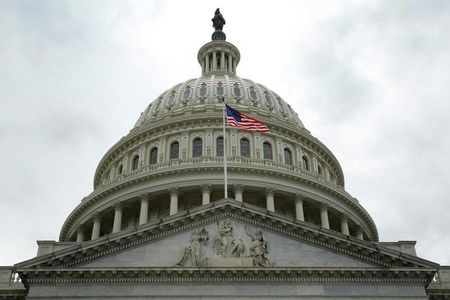
Investing.com – The United States narrowly avoided a government shutdown after Congress approved a spending extension until March 14, 2025, with $100 billion allocated for disaster relief and $30 billion for farm aid. But while the measure prevents an immediate crisis, Goldman Sachs warns that bigger financial issues loom.
One of the main points of contention – raising the debt limit – was left out of the latest draft law. However, Goldman notes, “Republican leaders have committed to raising the debt limit by $1.5 trillion next year in a ‘reconciliation’ bill, which could pass without bipartisan support. This would be coupled with $2.5 trillion in spending cuts over the next decade,” This is equivalent to 0.7% of the GDP.
The Wall Street firm estimates that the proposed $1.5 trillion increase in debt limits could push the deadline from July-August 2025 to early 2026. However, the exact timing depends on Treasury cash flows.
Despite this, the company admits that achieving the $2.5 trillion cuts will not be easy. “This is a clearer commitment that will be difficult to achieve,” the memo said, stressing that previous attempts to secure such savings have faced resistance.
Potential savings could target health programs, including Medicaid reforms and Medicare payment adjustments, which could generate as much as $1.7 trillion. Ending subsidies under the Affordable Care Act could cut another $300 billion over a decade, while repealing the Inflation Act could theoretically save nearly $500 billion over the same period.
However, Goldman warns that Republican lawmakers may not uniformly support such measures, limiting their potential impact.
“For example, we expect that support among some Republican lawmakers for some IRA provisions will limit savings to about $100 billion per 10 years (mainly through reduced electric vehicle incentives),” the company continued.
Tariff revenue could theoretically contribute, but Goldman stresses the difficulty of achieving the required near-unanimous support.
“The experience over the past few days highlights how difficult it will be to get the near-unanimous support needed to pass a fiscal package along party lines, and there will likely be many Republican lawmakers who oppose tariff hike legislation.” The note adds.
Looking ahead, Goldman sees two possible paths for fiscal policy in 2025. One option is a two-step reconciliation process – passing a smaller bill focused on immigration and debt limits, followed by a larger package that addresses tax cuts and broader spending adjustments.
The other path includes one comprehensive draft law. However, Goldman notes that “a two-step process seems more likely than one comprehensive package,” as the incoming administration may prioritize quick wins on immigration.
In this case, Republican leaders will likely begin preparing for the two-step fiscal strategy in January by beginning to pass a budget resolution to enable reconciliation legislation. However, this process will delay clarity on the full scope and details of the broader financial package for several months, according to Goldman.
https://i-invdn-com.investing.com/news/LYNXMPED6P1BD_L.jpg
Source link